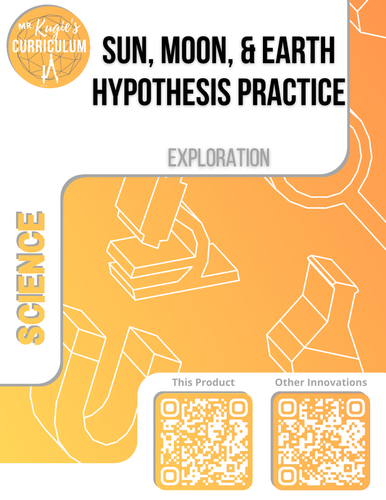




An independent and whole-group exploration of phenomenon related to how the Sun, Moon, and Earth interact using the scientific method. This resource touches on some key topics of early astronomy instruction: the Earth’s rotation, the Earth’s revolution around the Sun, moon phases, tides, eclipses, and the uneven heating of the Earth’s surface.
WHAT’S INCLUDEDThis resource contains:
–> 2 pages of rich, scientific questions related to the Sun, moon, and Earth
–> Teacher guide for implementation with plenty of links to other exciting resources about Space
–> Answer Key with explanations, sample diagrams, other resources, and digging deeper questions
I created an astronomy unit around the same time that my learners were also exploring the scientific method. As a way to reinforce the connection between the two, I developed this activity which prompts students to hypothesize about 6 key Earth-related questions.
IMPLEMENTATIONThis resource consists mainly of a worksheet which, through the teacher’s guidance, can facilitate deep conversation about how the heavenly bodies of our Solar System interact. The exploration begins with an independent task; learners will hypothesize about why certain phenomena occur, like “how do night and day occur?” or “what causes seasons?” Then a whole-group discussion brings about the variety of postulates in the room. Learners should be encouraged to model their thinking to their peers with a globe and a flashlight. The learning community then comes to an agreement on their collective theory of why a certain phenomenon happens. Then, after a little exploration together of the provided resources, learners are able to synthesize what they discovered through a drawing and explanation of their own.
POSSIBLE EXTENSIONSThis file includes multiple links to deeper questions about the universe or interesting developments in our understanding of Space.
MATERIALS/PRE-REQSBesides this resource, you may require:
–> Computers with internet access
–> A Globe (or something to model the Earth like a basketball)
–> A Flashlight (or a light to model the sun - must be bright & direct enough to cast shadows)
–> A “Moon” (something relative to the size of your “Earth” to model the moon like a tennis ball)
Something went wrong, please try again later.
This resource hasn't been reviewed yet
To ensure quality for our reviews, only customers who have purchased this resource can review it
Report this resourceto let us know if it violates our terms and conditions.
Our customer service team will review your report and will be in touch.